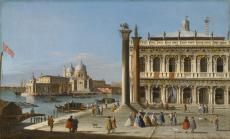


Commercial concerns have always led to optimistic and inventive solutions to problems of anonymity in the field of Italian view paintings, notably in the 1960s and 1970s. One particularly prevalent case is that of William James, who is well documented as a mid-18th-century painter of Venetian views. He has in recent decades been credited with a considerable oeuvre and, although scholarship in this area since the 1980s has resulted in far greater clarity, he continues to be described as the author of decorative copies after Canaletto (1697-1768) in a distinctive, colourful and linear style, despite the fact that not a single painting can be attributed to him with certainty. Another attribution which was in widespread usage for a time was ‘Jacopo Marieschi’, to whom these paintings were given when they were acquired in 1975. That attribution is in one important respect even more misguided, as Jacopo Marieschi (1711-1794) was a painter of religious subjects and – as far as is known – no relation of the well-known view painter Michele Marieschi (1710-1743).
This pair of decorative, colourful and well-preserved paintings (opposite and p. 155) is, however, closely related to the large group of works currently ascribed to the artist known as ‘The Master of the Langmatt Foundation Views’, or ‘Langmatt Master’, who was so christened after thirteen Venetian views in the Langmatt Foundation in Baden, Switzerland. In two sets, of which nine measure 47 x 73 cm and four measure 25.5 x 38 cm, those were introduced to a wider audience by their exhibition in 1994. The appellation has since gained general currency, the master being credited with a considerable number of paintings – capriccios, landscapes and views of Rome as well as of Venice – and recognised as a significant figure in Venetian view painting through the middle decades of the 18th century. While the only dated example among the paintings attributed to him (a view of Rome derived from a Canaletto drawing) is of 1746, he seems to have been quite attentive in recording topographical changes (notably stages in the construction of the Palazzo Grassi), which is particularly useful in establishing the parameters of his career. On topographical grounds, the Langmatt Foundation paintings can be dated around 1745- 1750. Following the death of Michele Marieschi in 1743, during Canaletto’s absence in England for most of 1746 to 1755, and before the emergence of Francesco Guardi (1712-1793) in the late 1750s, the master was evidently available to satisfy a demand which was otherwise little catered for. The quantity of work in this style and the wide range of quality show that he ran a busy studio.
At one time paintings by this hand were occasionally attributed to the Lucchese artist Gaetano Vetturali (1701-1783), who worked in Venice and who, according to A. Mazzarosa’s Guida di Lucca (1843), painted views which were mistaken for those of Canaletto. However, the Langmatt Master’s stylistic characteristics reveal nothing to suggest that he was not a Venetian native. More recently many of his paintings used to be attributed to Francesco Tironi (1745-1797), but Tironi was later and his style, known from a number of signed paintings and securely attributable drawings, is quite distinct. Dario Succi has recently proposed an identification with Apollonio Domenichini, who, according to Antonio Selva’s catalogue of the paintings in the collection of Count Bonomo Algarotti, completed in 1776, was born in 1715 and who was inscribed in the Venetian painters’ guild in 1757 and probably deceased by 1776. His name occurs several times in the correspondence, preserved in the library of the Museo Correr in Venice, between the Venetian dealer Giovanni Maria Sasso and John Strange, a British resident in Venice (1774-1786). the pair of capriccios once in the Algarotti Collection remains unidentified, however, and there are no signed or securely documented works. The main problem with this suggestion is that in one of the few early documentary references to him, ‘Menichino’ is described as a pupil of Luca Carlevarijs (1663-1730). The Langmatt Master’s style has little to do with that of Carlevarijs, but is intimately related to that of Michele Marieschi’s disciple Francesco Albotto (1721-1757).
A variant of The Piazza San Marco, Venice, Looking East forms part of the larger of the two sets in the Langmatt Foundation. Others are at Palace House, Beaulieu, Hampshire, in the collection of Baron Montagu of Beaulieu, and elsewhere. A much larger variant of The Piazzetta, Venice, with Santa Maria della Salute and the Dogana beyond was offered at Christie’s in 1986; that has a very definite relationship with the A. G. Leventis Collection painting in the three pairs of gentlemen (and one of the dogs) in the immediate foreground, as well as in the manner of depiction of the Fusta, the large galley moored on the left. The style of the Leventis Collection paintings differs, however, from that of the Langmatt Master in several respects. The tonality is lighter and the application of paint less textured, the Langmatt Master’s distinctively scratchy treatment of water not being apparent. The figures are vivacious and florid rather than the Langmatt Master’s characteristically stiff and spindly types. In these respects, the style is related to that of Luca Carlevarijs’ Swedish disciple Johan Richter (1665-1745), with whom there is some evidence that the Langmatt Master was in touch.